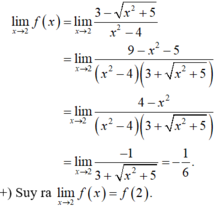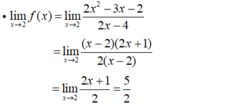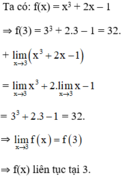Xét tính liên tục của hàm số f ( x ) = x 2 + 5 x + 4 x 3 + 1 n ế u x ≠ - 1 1 n ế u x = 1 trên tập xác định của nó.

Những câu hỏi liên quan
Xét tính liên tục của các hàm số sau: f ( x ) = x + 5 t ạ i x = 4
Hàm số  có tập xác định là [-5; +∞).
có tập xác định là [-5; +∞).
Do đó, nó xác định trên khoảng (-5; +∞) chứa x = 4
Vì 
nên f(x) liên tục tại x = 4
Đúng 0
Bình luận (0)
Xét tính liên tục của hàm số \(f\left( x \right) = \sin x + \cos x\) trên \(\mathbb{R}.\)
Vì hai làm lượng giác \(y = \sin x,y = \cos x\) liên tục trên \(\mathbb{R}\)
\( \Rightarrow f\left( x \right) = \sin x + \cos x\) liên tục trên \(\mathbb{R}\)
Đúng 0
Bình luận (0)
Xét tính liên tục của hàm số \(f\left( x \right) = {x^3} + 1\) tại \({x_0} = 1.\)
Ta có \(f\left( {{x_0}} \right) = f\left( 1 \right) = {1^3} + 1 = 2;\mathop {\lim }\limits_{x \to {x_0}} f\left( x \right) = \mathop {\lim }\limits_{x \to 1} \left( {{x^3} + 1} \right) = \mathop {\lim }\limits_{x \to 1} {x^3} + 1 = 1 + 1 = 2\)
\( \Rightarrow \mathop {\lim }\limits_{x \to 1} f\left( x \right) = f\left( 1 \right)\)
Vậy hàm số \(f\left( x \right)\) liên tục tại \({x_0} = 1.\)
Đúng 0
Bình luận (0)
Cho hàm số:
y
f
x
3
-
x
2
+
5
x
2
-
4...
Đọc tiếp
Cho hàm số: y = f x = 3 - x 2 + 5 x 2 - 4 x ≠ ± 2 - 1 6 x = 2
- Xét tính liên tục của hàm số f(x) tại x= 2?
+) Ta có :

- Vậy hàm số đã cho liên tục tại x = 2.
Đúng 0
Bình luận (0)
Xét tính liên tục của hàm số sau tại điểm
x
0
2
f
(
x
)
2
x
2
-
3
x
-
2
k
h
i
...
Đọc tiếp
Xét tính liên tục của hàm số sau tại điểm x 0 = 2
f ( x ) = 2 x 2 - 3 x - 2 k h i x ≠ 2 3 2 k h i x = 2

- Tập xác định D = R.
- Ta có: f(2) = 3/2.

- Vì  nên hàm số không liên tục tại x = 2.
nên hàm số không liên tục tại x = 2.
Đúng 0
Bình luận (0)
Bài 8: cho hàm số f(x) = (x ^ 2 + x - 6)/(x - 2); 2x + 1 khi x=2 khi x=2 Xét tính liên tục của hàm số tại x = 2
\(\lim\limits_{x\rightarrow2}f\left(x\right)=\lim\limits_{x\rightarrow2}\dfrac{x^2+x-6}{x-2}=\lim\limits_{x\rightarrow2}\dfrac{\left(x-2\right)\left(x+3\right)}{x-2}=\lim\limits_{x\rightarrow2}\left(x+3\right)=5\\ f\left(2\right)=5\\ \rightarrow\lim\limits_{x\rightarrow2}f\left(x\right)=f\left(2\right)\)
Suy ra f(x) liên tục tại x = 2.
Đúng 0
Bình luận (0)
Dùng định nghĩa xét tính liên tục của hàm số \(f\left( x \right) = 2{x^3} + x + 1\) tại điểm \(x = 2.\)
Hàm số \(f\left( x \right) = 2{x^3} + x + 1\) xác định trên \(\mathbb{R}\).
Ta có: \(\begin{array}{l}\mathop {\lim }\limits_{x \to 2} f\left( x \right) = \mathop {\lim }\limits_{x \to 2} \left( {2{x^3} + x + 1} \right) = {2.2^3} + 2 + 1 = 17\\f\left( 2 \right) = {2.2^3} + 2 + 1 = 17\\ \Rightarrow \mathop {\lim }\limits_{x \to 2} f\left( x \right) = f\left( 2 \right)\end{array}\)
Do đó hàm số liên tục tại x = 2.
Đúng 0
Bình luận (0)
Xét tính liên tục của hàm số sau trên tập xác định của nó:
f
(
x
)
x
2
-
5
x
+
6
k
h
i
x
3...
Đọc tiếp
Xét tính liên tục của hàm số sau trên tập xác định của nó: f ( x ) = x 2 - 5 x + 6 k h i x > 3 2 x + 1 k h i x ≤ 3
Xét tính liên tục của hàm số sau trên tập xác định của nó:

● Hàm số liên tục với mọi x ≠ 3.
● Tại x = 3, ta có:

⇒ Hàm số không liên tục tại x = 3.
- Vậy hàm số liên tục trên các khoảng (-∞ ; 3), (3 ; +∞).
Đúng 0
Bình luận (0)
Câu 1:Cho f(x) dfrac{sqrt{x+2}-sqrt{2-x}}{x}, x≠0. Phải bổ sung thêm giá trị f(0) bằng bao nhiêu thì hàm số f(x) liên tục tại x0?Câu 2:Xét tính liên tục của hàm sốa, f(x) left{{}begin{matrix}x+dfrac{3}{2}dfrac{sqrt{x+1}-1}{sqrt[3]{1+x}-1}end{matrix}right.khi x≤0 và x0 tại xo0b, f(x) left{{}begin{matrix}dfrac{x^3-x^2+2x-2}{x-1}3x+aend{matrix}right.với x1 và với x≥1, xo1
Đọc tiếp
Câu 1:
Cho f(x)= \(\dfrac{\sqrt{x+2}-\sqrt{2-x}}{x}\), x≠0. Phải bổ sung thêm giá trị f(0) bằng bao nhiêu thì hàm số f(x) liên tục tại x=0?
Câu 2:
Xét tính liên tục của hàm số
a, f(x)= \(\left\{{}\begin{matrix}x+\dfrac{3}{2}\\\dfrac{\sqrt{x+1}-1}{\sqrt[3]{1+x}-1}\end{matrix}\right.\)khi x≤0 và x>0 tại xo=0
b, f(x)= \(\left\{{}\begin{matrix}\dfrac{x^3-x^2+2x-2}{x-1}\\3x+a\end{matrix}\right.\)với x<1 và với x≥1, xo=1
1.
\(\lim\limits_{x\rightarrow0}\dfrac{\sqrt{x+2}-\sqrt{2-x}}{x}=\lim\limits_{x\rightarrow0}\dfrac{2x}{x\left(\sqrt{x+2}+\sqrt{2-x}\right)}=\lim\limits_{x\rightarrow0}\dfrac{2}{\sqrt{x+2}+\sqrt{2-x}}=\dfrac{2}{2\sqrt{2}}=\dfrac{\sqrt{2}}{2}\)
Vậy cần bổ sung \(f\left(0\right)=\dfrac{\sqrt{2}}{2}\) để hàm liên tục tại \(x=0\)
2.
a. \(f\left(0\right)=\lim\limits_{x\rightarrow0^-}f\left(x\right)=\lim\limits_{x\rightarrow0^-}\left(x+\dfrac{3}{2}\right)=\dfrac{3}{2}\)
\(\lim\limits_{x\rightarrow0^+}f\left(x\right)=\lim\limits_{x\rightarrow0^+}\dfrac{\sqrt{x+1}-1}{\sqrt[3]{1+x}-1}=\lim\limits_{x\rightarrow0^+}\dfrac{x\left(\sqrt[3]{\left(x+1\right)^2}+\sqrt[3]{x+1}+1\right)}{x\left(\sqrt[]{x+1}+1\right)}\)
\(=\lim\limits_{x\rightarrow0^+}\dfrac{\sqrt[3]{\left(x+1\right)^2}+\sqrt[3]{x+1}+1}{\sqrt[]{x+1}+1}=\dfrac{3}{2}\)
\(\Rightarrow f\left(0\right)=\lim\limits_{x\rightarrow0^+}f\left(x\right)=\lim\limits_{x\rightarrow0^-}f\left(x\right)\) nên hàm liên tục tại \(x=0\)
Đúng 1
Bình luận (0)
2b.
\(\lim\limits_{x\rightarrow1^-}f\left(x\right)=\lim\limits_{x\rightarrow1^-}\dfrac{x^3-x^2+2x-2}{x-1}=\lim\limits_{x\rightarrow1^-}\dfrac{x^2\left(x-1\right)+2\left(x-1\right)}{x-1}\)
\(=\lim\limits_{x\rightarrow1^-}\dfrac{\left(x^2+2\right)\left(x-1\right)}{x-1}=\lim\limits_{x\rightarrow1^-}\left(x^2+2\right)=3\)
\(\lim\limits_{x\rightarrow1^+}f\left(x\right)=f\left(1\right)=\lim\limits_{x\rightarrow1^+}\left(3x+a\right)=a+3\)
- Nếu \(a=0\Rightarrow f\left(1\right)=\lim\limits_{x\rightarrow1^-}f\left(x\right)=\lim\limits_{x\rightarrow1^+}f\left(x\right)\) hàm liên tục tại \(x=1\)
- Nếu \(a\ne0\Rightarrow\lim\limits_{x\rightarrow1^-}f\left(x\right)\ne\lim\limits_{x\rightarrow1^+}f\left(x\right)\Rightarrow\) hàm không liên tục tại \(x=1\)
Đúng 1
Bình luận (0)
Dùng định nghĩa xét tính liên tục của hàm số f ( x ) = x 3 + 2 x - 1 tại x 0 = 3 .










